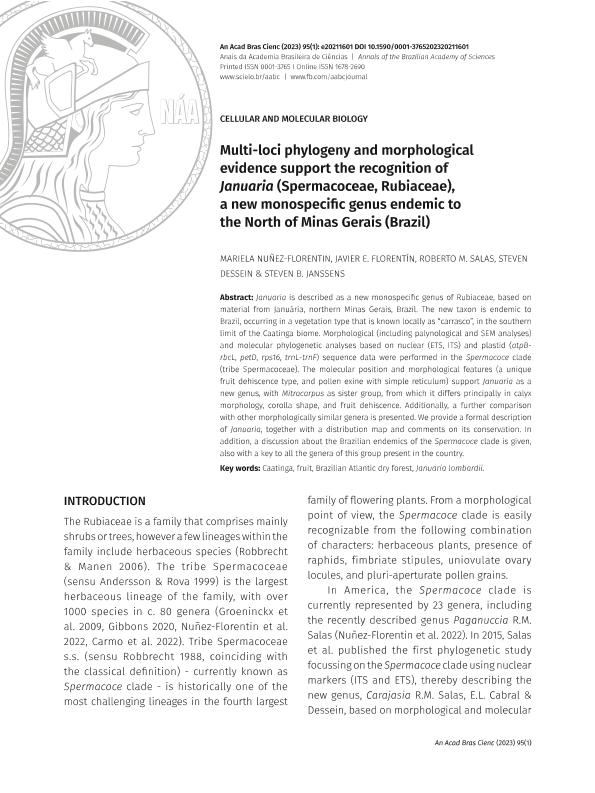Artículo
Multi-loci phylogeny and morphological evidence support the recognition of Januaria (Spermacoceae, Rubiaceae), a new monospecific genus endemic to the North of Minas Gerais (Brazil)
Nuñez Florentin, Mariela ; Florentín, Javier Elias
; Florentín, Javier Elias ; Salas, Roberto Manuel
; Salas, Roberto Manuel ; Dessein, Steven; Janssens, Steven B.
; Dessein, Steven; Janssens, Steven B.
 ; Florentín, Javier Elias
; Florentín, Javier Elias ; Salas, Roberto Manuel
; Salas, Roberto Manuel ; Dessein, Steven; Janssens, Steven B.
; Dessein, Steven; Janssens, Steven B.
Fecha de publicación:
03/2023
Editorial:
Academia Brasileira de Ciencias
Revista:
Anais da Academia Brasileira de Ciencias
ISSN:
0001-3765
e-ISSN:
1678-2690
Idioma:
Inglés
Tipo de recurso:
Artículo publicado
Clasificación temática:
Resumen
Januaria is described as a new monospecific genus of Rubiaceae, based on material from Januária, northern Minas Gerais, Brazil. The new taxon is endemic to Brazil, occurring in a vegetation type that is known locally as “carrasco”, in the southern limit of the Caatinga biome. Morphological (including palynological and SEM analyses) and molecular phylogenetic analyses based on nuclear (ETS, ITS) and plastid (atpBrbcL, petD, rps16, trnL-trnF) sequence data were performed in the Spermacoce clade (tribe Spermacoceae). The molecular position and morphological features (a unique fruit dehiscence type, and pollen exine with simple reticulum) support Januaria as a new genus, with Mitracarpus as sister group, from which it differs principally in calyx morphology, corolla shape, and fruit dehiscence. Additionally, a further comparison with other morphologically similar genera is presented. We provide a formal description of Januaria, together with a distribution map and comments on its conservation. In addition, a discussion about the Brazilian endemics of the Spermacoce clade is given, also with a key to all the genera of this group present in the country.
Palabras clave:
BRAZILIAN ATLANTIC DRY FOREST
,
CAATINGA
,
FRUIT
,
PHYLOGENY
Archivos asociados
Licencia
Identificadores
Colecciones
Articulos(IBONE)
Articulos de INST.DE BOTANICA DEL NORDESTE (I)
Articulos de INST.DE BOTANICA DEL NORDESTE (I)
Citación
Nuñez Florentin, Mariela; Florentín, Javier Elias; Salas, Roberto Manuel; Dessein, Steven; Janssens, Steven B.; Multi-loci phylogeny and morphological evidence support the recognition of Januaria (Spermacoceae, Rubiaceae), a new monospecific genus endemic to the North of Minas Gerais (Brazil); Academia Brasileira de Ciencias; Anais da Academia Brasileira de Ciencias; 95; 1; 3-2023; 1-24
Compartir
Altmétricas



